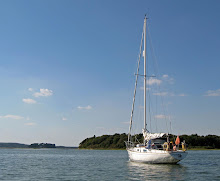The forecast was not good and certainly not suitable for two old codgers to make the next stage particularly in rough weather, including the still promised Force 9 or 10. Hence a few days rest in Arbroath.
Wednesday was a ‘make and mend’ day as various squalls come and went. It was good to have the cockpit canopy to shelter us from the worst of the rain.
On Thursday, we made a bus trip to Dundee to do the tourist bit particularly to visit Scott’s ship “Discovery” and the Polar Experience at Discovery Point. The countryside is very different from the highlands; we are very much now in the lowlands with rich agricultural land as far as we could see.
The Polar Experience exhibition is excellent and fully brings to life the hardships and privations of polar exploration at that time. The Discovery and the voyages she made are very thought provoking. A triple planked hull of different woods to give the strength to withstand being locked in the ice. A sailing ship with traditional square sails but an auxiliary steam engine. The wardroom chairs bolted down on swivels to allow people to turn round. And bunks along the side of the ship – apparently if a mattress touched a hull bolt or iron knee, it froze solid overnight and had to be thawed out before it could be moved. We were pondering how the crew got out onto the yards from the ratlins as it seemed a very long way to jump.
Then we walked along the waterfront to visit the Unicorn, a ship of the line dating from the Napoleonic Wars. She was built in Chatham but never rigged as the wars ended before she could be commissioned; she then became part of the ‘strategic reserve’ in case war with France broke out again, then a training ship and finally headquarters for the RNVR. During the First and Second World Wars she was based in Dundee as headquarters for the navy. She was finally de-commissioned in the 1960s and sold for £1 to a charity to preserver her. Because of her peculiar history she is claimed to be the best preserved ship of the line of her time.
Amongst the showers and squalls, Friday was again make and mend plus exploration of Arbroath.
The town began with the foundation of Arbroath Abbey. This was founded in 1178 by King William the Lion. Today it is a large ruin.
Arbroath’s first harbour was originally built in 1394 at Danger Point by the Abbot. But it was destroyed in a gale and another harbour built around 1734. The present harbour was begun in 1842 and was completed with the opening of the wet dock in 1877. Subsequently further breakwaters were built to form the outer harbour. The harbour was originally a commercial port trading with North America, the Continent and around the coasts of Britain. The Town Council invited some fisher families to Arbroath in 1830 and the local fishing industry developed from that date. Today there is some fishing but the inner dock is predominantly given over to yachts.
The harbour at Arbroath is dominated by the Signal Tower, built over 200 years ago to communicate with the Bell Rock Lighthouse 11.5 miles off shore. The Bell Rock Lighthouse was built in 1810 by Robert Stevenson. Signalling was by means of copper balls hoisted to show all was alright; if no ball was seen on the lighthouse a boat was sent out to investigate. When a baby was born on shore to a keeper on the lighthouse, news of the birth was sent by hoisting a pair of trousers for a boy or dress for a girl.
Arbroath is of course famous for the Arbroath Smokie. Pairs of haddock are tied by their tails and suspended over square oak barrels some 1.5m square. They are hot smoked and cooked right through by various local families each with their own recipe. Today ther are several smokeries around the harbour with fish shops selling all manner of fish and seafood.














No comments:
Post a Comment